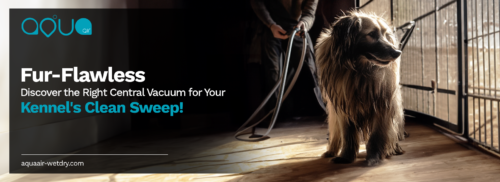
Central Vacuum Systems for Veterinary Clinics
Veterinary clinics serve as vital hubs for pet care, catering to a diverse range of animals and medical needs. Amidst the hustle and bustle of treating patients, maintaining a clean and hygienic environment is paramount. Traditional cleaning methods may fall short when it comes to efficiently managing the diverse range of contaminants encountered in a veterinary setting. This is where veterinary central vacuums step in as a game-changer.
Understanding Central Vacuum Systems
Clinic cleaning systems are advanced cleaning solutions that differ significantly from traditional portable vacuum cleaners. Instead of lugging around a cumbersome vacuum unit, central vacuum systems are fixed installations, typically consisting of a powerful suction unit installed in a central location, such as a utility room, and a network of pipes running throughout the building. These pipes connect to vacuum inlets strategically positioned across various rooms or zones within the facility.
Benefits of Central Vacuum Systems in Veterinary Clinics
- Enhanced Air Quality: Veterinary clinics often contend with a multitude of airborne contaminants, including pet hair, dander, fur, bacteria, and odors. Central vacuum systems effectively capture and remove these particles, thereby improving air quality and reducing the risk of allergic reactions or respiratory issues among staff and patients.
- Comprehensive Cleaning: With strategically positioned vacuum inlets throughout the clinic, cleaning becomes more accessible and more efficient. Staff can quickly connect hoses to the nearest inlet, eliminating the need to transport heavy equipment from room to room.
- Reduced Cross-Contamination: Traditional vacuum cleaners can inadvertently spread contaminants from one area to another, increasing the risk of cross-contamination. Central vacuum systems mitigate this risk by containing collected debris in a central unit, away from occupied spaces.
- Quiet Operation: Unlike conventional vacuum cleaners that produce loud noise, central vacuum systems operate quietly. This is particularly advantageous in veterinary clinics, where minimizing noise levels can help reduce stress among animals and create a calmer environment.
- Durable and Low Maintenance: Clinic cleaning systems are designed for durability and require minimal maintenance compared to portable vacuum cleaners. Routine tasks typically include emptying the collection bin and periodic filter replacements.
- Scalability: Whether you’re operating a small veterinary clinic or a large-scale animal hospital, central vacuum systems can be tailored to suit the specific needs and size of your facility. They offer scalability and flexibility, allowing for seamless expansion or modification as your clinic grows.
Functionalities and Components
Central vacuum systems for veterinary clinics consist of several key components, each playing a crucial role in their functionality:
- Suction Unit: The heart of the system, the suction unit, is typically installed in a designated utility area. It generates powerful suction to remove dirt, debris, and contaminants from the clinic environment.
- Vacuum Inlets: Strategically positioned throughout the clinic, vacuum inlets serve as access points for connecting hoses and accessories to the central vacuum system.
- Piping Network: A network of durable PVC pipes runs behind walls, above ceilings, or beneath floors, connecting the suction unit to the vacuum inlets. These pipes transport dirt and debris to the central unit for containment.
- Hoses and Accessories: Flexible hoses and a variety of attachments enable staff to efficiently clean different surfaces and areas within the clinic, including floors, upholstery, and exam tables.
- Collection Bin and Filtration System: The collection bin captures dirt and debris collected by the central vacuum system, while the filtration system traps fine particles and allergens, preventing them from re-entering the clinic environment.
Installation Considerations
Installing a veterinary central vacuums in a clinic requires careful planning and consideration of several factors:
- Clinic Layout: Assess the layout of the clinic to determine the optimal placement of vacuum inlets and the suction unit. Consider factors such as the size of the facility, the number of treatment rooms, and high-traffic areas.
- Power Requirements: Ensure that the electrical system can accommodate the power requirements of the central vacuum system. Consult with an electrician to assess existing wiring and make any necessary upgrades.
- Noise Considerations: Position the suction unit in a utility room or other designated area to minimize noise disruption within the clinic. Choose a location away from patient exam rooms and other sensitive areas.
- Accessibility: Ensure that vacuum inlets are conveniently located throughout the clinic to facilitate easy access for staff. Consider installing additional inlets in areas with high levels of foot traffic or pet activity.
- Maintenance Access: Design the installation to allow for easy access to the suction unit, collection bin, and filtration system for routine maintenance tasks, such as emptying the bin and replacing filters.
- Future Expansion: Plan the installation with future expansion in mind, allowing for the addition of more vacuum inlets or the extension of the piping network as the clinic grows.
Conclusion
Veterinary central vacuums offer a myriad of benefits for veterinary clinics, ranging from improved air quality and hygiene to enhanced efficiency and convenience. By investing in a central vacuum system tailored to the unique needs of their facility, veterinary professionals can create a cleaner, healthier environment for both patients and staff. With careful planning and installation, central vacuum systems prove to be indispensable assets in the quest for optimal cleanliness and hygiene in veterinary clinics.
Incorporating a central vacuum system into your veterinary clinic’s cleaning regimen isn’t just a smart investment—it’s a commitment to providing the best possible care for your furry patients and creating a welcoming environment for their human companions.




No Comments